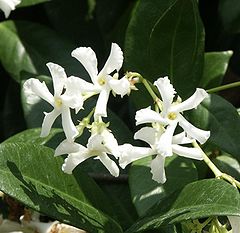Trachelospermum
| Trachelospermum subsp. var. | Confederate jasmine, Star jasmine | |||||||||||||||||||||||||||||||||||||||||||||||||||||||
|---|---|---|---|---|---|---|---|---|---|---|---|---|---|---|---|---|---|---|---|---|---|---|---|---|---|---|---|---|---|---|---|---|---|---|---|---|---|---|---|---|---|---|---|---|---|---|---|---|---|---|---|---|---|---|---|---|

|
|
| ||||||||||||||||||||||||||||||||||||||||||||||||||||||
| ||||||||||||||||||||||||||||||||||||||||||||||||||||||||
Trachelospermum (pronounced /trəˌkiːlɵˈspɜrməm/)[1] is a genus of about 15 species of evergreen woody vines in the family Apocynaceae, native to southern and eastern Asia (14 species) and southeastern North America (one species, T. difforme).
They have long stems climbing to 12 m or more high in trees. The leaves are opposite, simple broad lanceolate to ovate, 2-8 cm long and 0.5-4 cm broad. The flowers are salverform (like those of Phlox), simple, 2.5-7 cm broad, with five white, pale yellow or purple petals joined together at the base to form a tube.
| Standard Cyclopedia of Horticulture |
|---|
|
Trachelospermum (Greek, neck and seed, referring to the fact that the seed has a neck). Syn., Rhynchospermum. Apocynaceae. Glabrous or slightly tomentose-puberulent shrubs, the typical species tall-climbing, grown in the warmhouse and a favorite out-of-doors in the South. Leaves opposite, distantly feather-veined: cymes lax, terminal or pseudo-axillary: fls. white; calyx small, 5-parted, with 5-10 scales or glands inside at the base; corolla salver-shaped, tube cylindrical, 5-lobed, lobes oblong, twisted to the left, overlapping to the right; disk annulate, truncate or 5-lobed; ovary 2-carpelled: follicles elongate, slender, terete. — About 16 species, E. Asia and Malaya. Trachelospermum is a most satisfactory greenhouse shrub for a general collection. It requires no special treatment, except that the plants should be kept on the dry side during the winter. It requires several years to work up a good-sized specimen. Young plants should be given warmhouse treatment and encouraged to grow. Large well-established specimens thrive in a coolhouse. In summer the pots may be plunged outdoors in a partially shaded position. The species is propagated by cuttings of half-ripened wood taken with a heel in spring. The star jasmine is one of the many good old standard greenhouse plants that are too little seen nowadays. The specimens require considerable room, and the gardener is sometimes compelled to keep them in a cold pit until the chrysanthemum season is over, although this treatment is not to be advised. It is a tender evergreen shrubby climber from China, with fragrant white five-lobed flowers. It is a favorite in the South, where it, is grown out-of-doors and known as the "confederate jessamine." In northern conservatories it is generally known under its synonym, Rhynchospermum. Handsome specimens may be grown in large tubs, making dense bushes 3 to 4 feet high and as much in diameter. T. divaricatum, Kanitz (T. crocostomum, Stapf). Similar to T. jasminoides in habit, but differs in having slightly smaller buff or pale orange-colored fls. with exserted stamens, pointed in bud, and smaller lvs. Japan, Korea. G.W. 12, p. 415.—It is more hardy than T. jasminoides. CH
|
Cultivation
- Do you have cultivation info on this plant? Edit this section!
Propagation
- Do you have propagation info on this plant? Edit this section!
Pests and diseases
- Do you have pest and disease info on this plant? Edit this section!
Species
- Selected specieswp
- Trachelospermum asiaticum - Yellow Star-jasmine
- Trachelospermum assamense
- Trachelospermum axillare
- Trachelospermum bodinieri
- Trachelospermum brevistylum
- Trachelospermum difforme - Climbing Dogbane
- Trachelospermum dunnii
- Trachelospermum jasminoides - Star-jasmine or Trader's Compass
- Trachelospermum lanyuense
- Trachelospermum lucidum
- Trachelospermum mandienum
- Trachelospermum nitidum
Gallery
If you have a photo of this plant, please upload it! Plus, there may be other photos available for you to add.
References
- Standard Cyclopedia of Horticulture, by L. H. Bailey, MacMillan Co., 1963
External links
- w:Trachelospermum. Some of the material on this page may be from Wikipedia, under the Creative Commons license.
- Trachelospermum QR Code (Size 50, 100, 200, 500)
Cite error:
<ref> tags exist, but no <references/> tag was found


